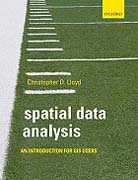
What is the shortest route between one point and another in a road network? Where is the incidence of disease the highest? How does rainfall correlate withaltitude? How does the concentration of a pollutant vary in space, and where do high concentrations correlate with densely populated areas? Geographical or spatial data play a vital role in many parts of daily life. We are dependenton information about where things are located and about the attributes of those things, either directly, as in the use of a map for navigating around a city, or indirectly, where we use resources like water or gas. Making use of spatial data requires a whole set of approaches to extract information from those data and make them useful. Underpinning these approaches is the analysis of data. Spatial Data Analysis introduces key principles about spatial data andprovides guidance on methods for their exploration; it provides a set of key ideas or frameworks that will give the reader knowledge of the kinds of problems that can be tackled using the tools that are widely available for the analysis of spatial data. The approach is gradual and systematic; the initial focus is on themes that follow through the rest of the book. These key ideas are introduced, illustrated, and restated to ensure that readers develop a clear understanding of them. INDICE: Chapter 1. Introduction 1.1: Spatial data analysis 1.2: Purpose ofthe book 1.3: Key concepts 1.4: Structure of the book 1.5: Further reading Chapter 2. Key concepts 1: GIS 2.1: Introduction 2.1: Data and data models 2.2.1: Raster data 2.2.2: Vector data 2.2.3: Topology 2.2.4: Rasters and vectors inGIS software 2.3: Databases 2.3.1: Database management 2.3.2: The Geodatabase2.5: Georeferencing 2.6: Geocoding 2.7: Spatial scale 2.8: Spatial data collection 2.9: Sources of data error 2.9.1: Uncertainty in spatial data analysis 2.10: Visualising spatial data 2.11.1: Boolean logic Chapter 3. Key concepts 2:statistics 3.1: Introduction 3.2: Univariate statistics 3.3: Multivariate statistics 3.4: Inferential statistics 3.5: Statistics and spatial data 3.6: Summary 3.7: Further reading Chapter 4. Key concepts 3: spatial data analysis 4.1:Introduction 4.2: Distances 4.3: Measuring lengths and perimeters 4.3.1: Length of vector features 4.4: Measuring areas 4.4.1: Areas of polygons 4.5: Distances from objects: buffers 4.5.1: Vector buffers 4.5.2: Raster proximity 4.6: Moving windows: basic statistics in sub-regions 4.7: Geographical weights 4.9:The ecological fallacy and the modifiable areal unit problem 4.10: Merging polygons 4.11: Summary 4.12: Further reading Chapter 5. Combining data layers 5.1: Introduction 5.2: Multiple features: overlays 5.2.1: Point in polygon 5.2.2: Overlay operators 5.2.3: 'Cookie cutter' operations: erase and clip 5.2.4: Applications and problems 5.3: Multicriteria decision analysis 5.4: Case study 5.5: Summary 5.6: Further reading Chapter 6. Network analysis 6.1: Introduction 6.2: Networks 6.3: Network connectivity 6.4: Summaries of network characteristics 6.5: Identifying shortest paths 6.6: The travelling salesperson problem 6.7: Location-allocation problems 6.8: Case study 6.9: Summary 6.10: Further reading Chapter 7. Exploring spatial point patterns 7.1: Introduction 7.2: Basic measures 7.3: Exploring spatial variations in point intensity 7.3.1: Quadrats 7.3.2: Kernel estimation 7.4: measures based on distances between events 7.4.1: Nearest neighbour methods 7.4.2: K function 7.5: Applications and other issues 7.6: Case study 7.7: Summary 7.8: Further reading Chapter 8. Exploring spatial patterning in data values 8.1: Introduction 8.2: Spatial autocorrelation8.3: Local statistics 8.4: Local univariate measures 8.4.1: Local spatial autocorrelation 8.5: Regression and correlation 8.5.1: Spatial regression 8.5.2: Moving window regression (MWR) 8.5.3: Geographically weighted regression (GWR)8.6: Other approaches 8.7: Case studies 8.7.1: Spatial autocorrelation analysis 8.7.2: GWR 8.8: Summary 8.9: Further reading Chapter 9. Spatial interpolation 9.1: Introduction 9.2: Interpolation 9.3: Triangulated irregular networks 9.4: Regression for prediction 9.5: Inverse distance weighting 9.6: Thin plate splines 9.7: Ordinary kriging 9.7.1: Variogram 9.7.2: Kriging 9.8: Other approaches and other issues 9.9: Areal interpolation 9.10: Case studies 9.10.1: Variogram estimation 9.10.2: Spatial interpolation 9.11: Summary 9.12: Further reading Chapter 10. Analysis of grids and surfaces 10.1: Introduction 10.2: Map algebra 10.3: Image processing 10.4: Spatial filters 10.5: Derivatives of altitude 10.6: Other products derived from surfaces 10.7: Case study 10.8: Summary10.9: Further reading Chapter 11. Summary 11.1: Review of key concepts 11.2: Other issues 11.3: Problems 11.4: Where next? 11.5: Summary and conclusions References Appendix A. Matrix multiplication Appendix B. The exponential function Appendix C. The inverse tangent Appendix D. Line Intersection Appendix E. Ordinary least squares Appendix F. Ordinary kriging system Appendix G. Problems and solutions
- ISBN: 978-0-19-955432-4
- Editorial: Oxford University
- Encuadernacion: Rústica
- Páginas: 218
- Fecha Publicación: 03/12/2009
- Nº Volúmenes: 1
- Idioma: Inglés
